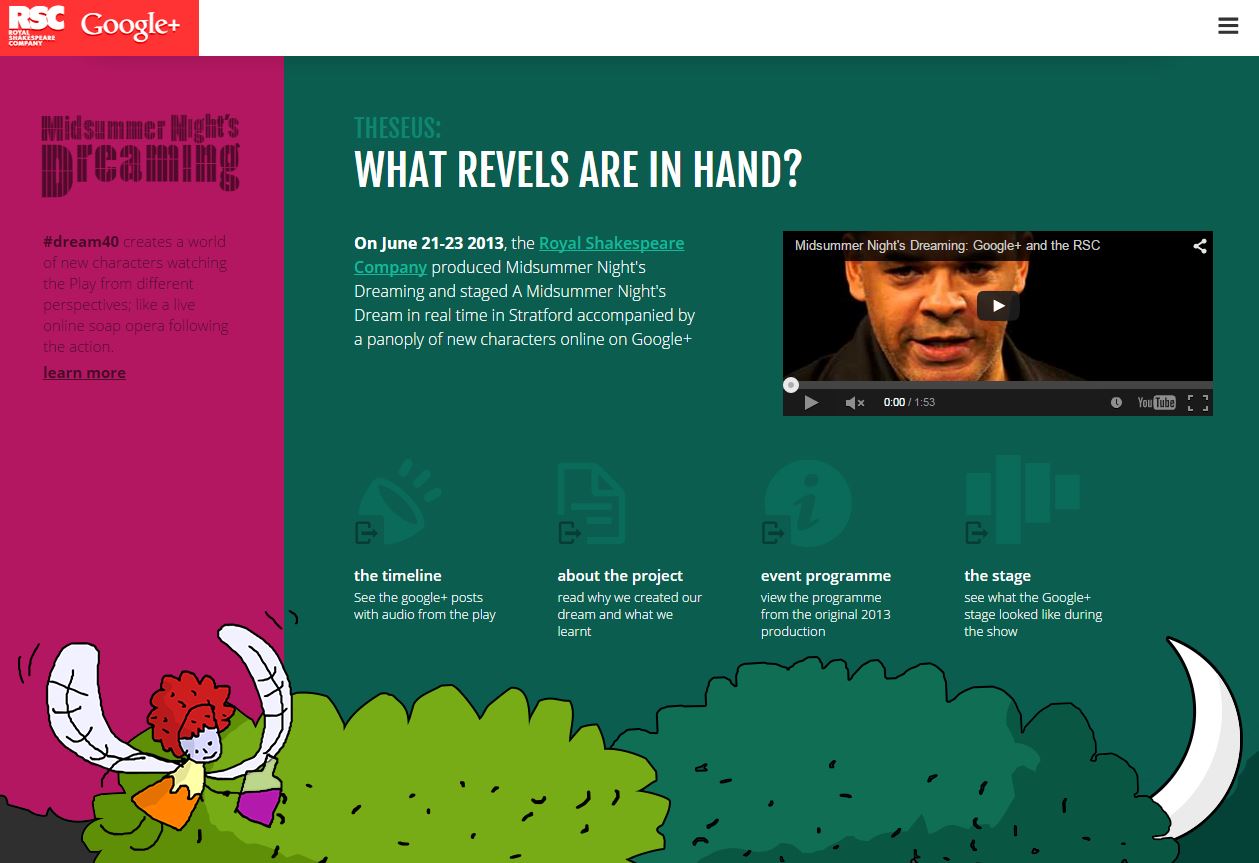
The Midsummer Night's Dreaming webpage
Naturally thinking digital
Amy Rushby explains how digital technologies have allowed the RSC to extend its reach and provided more opportunities for it to get creative.
It is difficult to decipher when the arts first ventured into digital. Was it when we launched our first websites or sent our first emails to audiences? Or when we set up a Facebook page or sent our debut tweets out into the ether? Or maybe that first digital project when we aimed to engage with a wider audience through online streaming or something more than just a website?
Whenever it was, digital is now embedded in our wider strategies, whether that is our overall business, communications or artistic strategies. In the recent Digital Culture 2014 report from Nesta, Arts Council England and the Arts and Humanities Research Council, 51% of the arts organisations surveyed reported that digital technology was important or essential to their business models. This had increased from 34% in the previous year’s report – demonstrating that digital is now a lot a more than a ‘nice to have’ for our sector.
At the Royal Shakespeare Company (RSC) our digital journey is forever propelling us forward. We became active on social media seven years ago, have an ever-evolving website, send email communications to our audiences every week and publish online content in the form of blogs and video. We also broadcast our productions live to cinemas and have been fortunate enough to produce digital projects working alongside and learning from Google Creative Labs and a wealth of digital artists. From a communications point of view, digital is now embedded in what we do from our daily postings on social media, retargeted online ad campaigns, getting our heads around search engine optimisation and developing an online content strategy. We now naturally think digital when devising our marketing and communications campaigns.
Social media has played a large part at breaking down preconceptions about the RSC brand
However, the onset of digital communications has not meant a decline in our use of traditional communication and marketing techniques. If anything, our season brochure is an essential sales tool, as is our members’ newsletter. Direct mail communications also continue to perform exceedingly well, proving that for RSC audiences at least, something through the letterbox is still tantalising and ultimately effective.
However, what digital has allowed us to do is extend our reach, and today we can confidently say that we communicate with a truly international audience, whether that is through our tweets, international live cinema broadcasts or projects such as Midsummer Night’s Dreaming. This project in particular, using the platform of Google+, allowed us to reach Shakespeare fans across the world, removing the physical barriers. By taking Shakespeare to an online arena, anyone around the world could access our work and be a contributor – 1,000 people were part of the online Google+ creative community, actively playing a role in the project. Our ambition is that at some point these people will be able to experience an RSC production, either on tour, in London or Stratford-upon-Avon. The same applies for live cinema broadcasts which are now being shown in the US, Australia, Canada and India.
Digital has allowed for further creativity and innovation. Social media channels offer the perfect platform for experimenting with new ideas and our understanding of social media communities is continuing to develop. Like most arts organisations, social media is our primary route for online content distribution, offering audiences a glimpse behind the scenes and access to the creative process. However, we should not forget the social ethos of social media – making it about conversation. Social media has played a large part at breaking down preconceptions about the RSC brand, has allowed us to learn more about our audiences and listen and respond accordingly. Running initiatives such as Twitter interviews has also allowed audiences, wherever they are, to connect with the creatives we work with, in real time, in an open way. Back in 2010 we launched our first social media experiment Such Tweet Sorrow, a massive leap for a company not known for digital innovation. The story of Romeo and Juliet played out on Twitter over a five-week period, and although the experiment divided critics and audiences it was most certainly an important learning curve that has had an impact on more recent digital projects.
So, what next? It is interesting to see how technology and performance and art itself are merging. Audiences are now creators using Instagram and Vine, and new technologies becoming more readily available has led to a wealth of opportunities for artists leading to new and unforgettable experiences for our audiences.
For communications, mobile is certainly the key opportunity, with more and more audiences accessing our digital presence via smartphones and tablets. We have already experimented with releasing season brochures and programmes to the App Store available to download to iPad. But is this what audiences want? Sometimes it is difficult to know. However, like a lot of arts organisations, we are restricted in what we can achieve due to lack of funding and time – 70% of arts organisations which contributed to the Digital Culture 2014 report cited that as a prominent barrier. It is therefore important to prioritise rather than try to take advantage of every digital opportunity and platform that arises. Either way, digital is here to stay so let’s embrace what it offers and learn to use it to our advantage.
Amy Rushby is Digital Marketing Officer at the Royal Shakespeare Company.
www.rsc.org.uk
Join the Discussion
You must be logged in to post a comment.